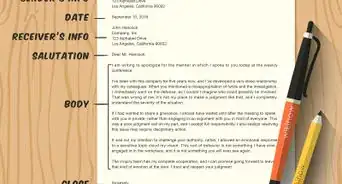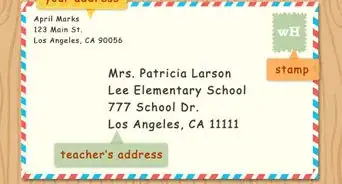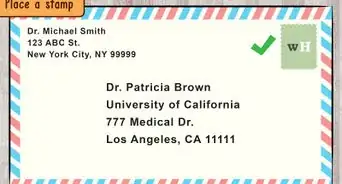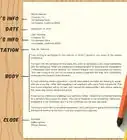This article was co-authored by David Katona. David Katona is an Immigration Lawyer and the Founder of Katona & Associates PLLC in New York City. With over 20 years of experience, he specializes in business immigration and green card sponsorship. He earned a law degree from American University Washington College of Law, a Master of International Affairs from American University’s School of International Service, and a BS in Business from Wake Forest University. Super Lawyers named him a Super Lawyer - Business Immigration in 2014, 2016-2022, and a Rising Star - Business Immigration in 2011. His firm was also rated by Best Lawyers as a Tier 1 immigration firm in NYC and Tier 2 nationally from 2020-2023. David is a member of the American Immigration Lawyers Association (AILA) and the NYC Bar Association.
wikiHow marks an article as reader-approved once it receives enough positive feedback. In this case, 86% of readers who voted found the article helpful, earning it our reader-approved status.
This article has been viewed 391,845 times.
People involved in immigration-related proceedings often need to support their applications with reference letters from community members and colleagues. These letters are used by judges and other government officials to assess whether the person involved in the immigration proceeding has good moral character. If you have been asked to write a letter, then you should take the time to make sure it contains all necessary information.
Steps
Preparing to Write the Letter
-
1Understand the kind of immigration proceeding. The first step in writing the letter is to find out what kind of proceeding the letter applicant is involved in. For example, reference letters may be used during immigration deportation or removal proceedings. The letter may also be used as part of a person’s application for naturalization. Other reasons for a letter include:
- To prove a relationship, such as a bona fide marriage
- As confirmation of employment or residence
- As evidence of abuse (emotional or physical)
- To confirm a credible fear of persecution held by a person seeking asylum
-
2Talk to the requestor. You should feel free to ask the requestor to put together a list of points they would like you to highlight in the letter. For example, the requestor may want you to share an experience working on a specific project, their passion for U.S. history, or specific personal anecdotes.
- Additionally, you may also ask the requestor for a resume or other background information. You can use this information to guide the writing process.
Advertisement -
3Find samples. You can find examples of immigration reference letters on the internet using a basic search. Be sure to revise whatever sample you find to fit your particular purposes. You must convey sincerity and credibility in your letter.
Writing the Letter
-
1Insert the date and salutation. At the top of the letter, you should include the date. A couple lines down, include the salutation. If you do not know who you are addressing, then you can state “To whom it may concern”.[1]
- If you are the applicant’s employer, then you should put the letter on company or organizational letterhead.
-
2Include an introduction. Use the first paragraph to introduce yourself. State your name, profession, and relationship to the requestor. Also include your own citizenship status.[2]
- Also state how long you have known the requestor, referencing dates, locations, job titles, etc.
- Sample language might be: “My name is Reverend Michael Smith. I am a U.S. citizen and a pastor at the United Methodist Church of Boston, Massachusetts.”
- Alternately, if you are an employer, you would state, “I am Carol Smith, assistant director of human resources at ABC Corp., where I have supervised Andrea Smith for the past three years, from April 2012 to present.”
-
3Describe the applicant’s character traits. In the second paragraph, you should provide specific examples that illustrate whatever the applicant is trying to prove to immigration officials. For example, the applicant may need a testimonial of good character traits to support naturalization or to avoid deportation. Alternately, the applicant might need you to establish that his or her romantic relationship is not a sham. Or, the applicant might need to prove that persecution in their home country caused trauma. Regardless of the content, try to be as concrete as possible.
- You could write, “I have met few people with as much compassion as Rosa Martinez. After attending my church for only two weeks, she volunteered for the soup kitchen and within two months was the lead volunteer on the weekend shift. It was in this capacity that Ms. Martinez found herself alone with a man who was deeply depressed and suicidal. After calling me, she stayed with the man for two hours until I was able to summon medical personnel to assist.”
- You may also be called upon to write a letter about the requestor’s relationship with a spouse. Sometimes, immigration officials claim that a marriage is a sham perpetrated to help one party get a green card. In this situation, you would want to write about the requestor’s relationship. Accordingly, you could state, “The bond Kelly Smith shares with her new husband, Adam Crouch, is impressive. As their friend and neighbor for the past two years, I have seen them gardening together, going for long walks, and sitting down to dinner nearly every night. When they came to my wedding anniversary party, they held hands and talked easily with the guests. It was as if I were seeing me and my husband in the early stages of our marriage.”
- If you are writing to offer evidence of abuse, then you should explain why you think the applicant suffered trauma in his or her home country. You should translate medical diagnoses into layperson’s terms. Provide specifics. For example, you might report that the person suffers from nightmares, weight loss, and other signs of anxiety.
-
4Explain work ethic, if relevant. If the requestor is an employee or volunteer, then you will want to include the requestor’s job title as well as their skills. Include information about the dates and location of employment.
- It is also important to give an opinion on the requestor’s honesty and trustworthiness, using specifics. For example, do not simply state, “Mr. Alcott has a fine moral character and cares about people.” That is too vague. You will need details to show the reader why you believe the requestor has the character traits you say he does.[3]
- Instead, you could write: “The first six months Mr. Alcott drove the shuttle bus from the homeless shelter to the soup kitchen across town. He was timely and always friendly with both the staff and our clients. Once, a client lost his wallet on the bus. After Mr. Alcott found it, he immediately turned it in to me. No money was missing.”
-
5Conclude with a heartfelt recommendation. The letter should close with a strong recommendation that the requestor get the relief that he or she is requesting. If the requestor is trying to avoid deportation, then you would want to state, “Based on my close acquaintance with Mr. Alcott, I strongly recommend that he not be deported.”[4]
- If the letter is in support naturalization, then you could state, “In my opinion, Mr. Alcott would be a credit to the country. Accordingly, I recommend that he be naturalized as a citizen of the United States as soon as possible.”
-
6Add your contact information. You need to give the government official who reads your letter a means of contacting you. You should add your work phone number and email at the end of the letter. If your mailing address has not been included as part of the letterhead, then include the mailing address here as well. Also state what times are good to contact you.
- After adding the contact information, insert “Sincerely” and then space down a few lines and type your name.
-
7Sign the letter. Use blue or black ink. You do not have to have the letter notarized, but you may want to consider doing so. Having the letter notarized will remove any doubt as to your signature. If the requestor is in the middle of deportation proceedings, then you should get the letter notarized.[5]
- If you want to have the letter notarized, then hold off on signing and take the letter to a notary public. Be sure to bring sufficient personal identification. A valid driver’s license or passport should be sufficient.
- To find a notary near you, use the locator from the American Society of Notaries. Notaries may also be found at most large banks as well as at courthouses.
Expert Q&A
-
QuestionWhat should a good reference letter include?
 David KatonaDavid Katona is an Immigration Lawyer and the Founder of Katona & Associates PLLC in New York City. With over 20 years of experience, he specializes in business immigration and green card sponsorship. He earned a law degree from American University Washington College of Law, a Master of International Affairs from American University’s School of International Service, and a BS in Business from Wake Forest University. Super Lawyers named him a Super Lawyer - Business Immigration in 2014, 2016-2022, and a Rising Star - Business Immigration in 2011. His firm was also rated by Best Lawyers as a Tier 1 immigration firm in NYC and Tier 2 nationally from 2020-2023. David is a member of the American Immigration Lawyers Association (AILA) and the NYC Bar Association.
David KatonaDavid Katona is an Immigration Lawyer and the Founder of Katona & Associates PLLC in New York City. With over 20 years of experience, he specializes in business immigration and green card sponsorship. He earned a law degree from American University Washington College of Law, a Master of International Affairs from American University’s School of International Service, and a BS in Business from Wake Forest University. Super Lawyers named him a Super Lawyer - Business Immigration in 2014, 2016-2022, and a Rising Star - Business Immigration in 2011. His firm was also rated by Best Lawyers as a Tier 1 immigration firm in NYC and Tier 2 nationally from 2020-2023. David is a member of the American Immigration Lawyers Association (AILA) and the NYC Bar Association.
Immigration Lawyer Normally, reference letters are documents where a person has to show that someone is extraordinary. Typically, the author of the letter has to provide enough background about themselves to qualify as an expert in the field of extraordinary ability in which the individual is applying for the visa. They also have to provide enough detail about the various achievements that the visa applicant has on their resume and why those achievements make the visa applicant sort of distinguished or more recognized than their peers.
Normally, reference letters are documents where a person has to show that someone is extraordinary. Typically, the author of the letter has to provide enough background about themselves to qualify as an expert in the field of extraordinary ability in which the individual is applying for the visa. They also have to provide enough detail about the various achievements that the visa applicant has on their resume and why those achievements make the visa applicant sort of distinguished or more recognized than their peers.
Expert Interview

Thanks for reading our article! If you'd like to learn more about writing a reference letter for immigration, check out our in-depth interview with David Katona.
References
- ↑ https://www.sample-resignation-letters.com/writing-a-strong-immigration-reference-letter-for-a-friend-with-sample.html
- ↑ https://www.sample-resignation-letters.com/writing-a-strong-immigration-reference-letter-for-a-friend-with-sample.html
- ↑ https://www.sample-resignation-letters.com/writing-a-strong-immigration-reference-letter-for-a-friend-with-sample.html
- ↑ https://www.sample-resignation-letters.com/writing-a-strong-immigration-reference-letter-for-a-friend-with-sample.html
- ↑ https://www.sample-resignation-letters.com/writing-a-strong-immigration-reference-letter-for-a-friend-with-sample.html
About This Article
Before you write a reference letter for someone's immigration proceeding, make sure you understand what type of letter they need, so you know what to share. Depending on the circumstances, you may want your letter to prove a relationship, like a bona fide marriage, or provide evidence of physical or emotional abuse. Once you know what to write, start your letter with the date and a salutation, such as "To whom it may concern." Then, use the first paragraph of your letter to introduce yourself and your relationship to the requestor. In the second paragraph, describe the applicant's character traits, providing specific examples that illustrate whatever the applicant is trying to prove to immigration officials. Finally, conclude your letter with a heartfelt recommendation, your contact information, and your signature. For more tips from our Law co-author, like how to get your letter notarized, keep reading.









































































